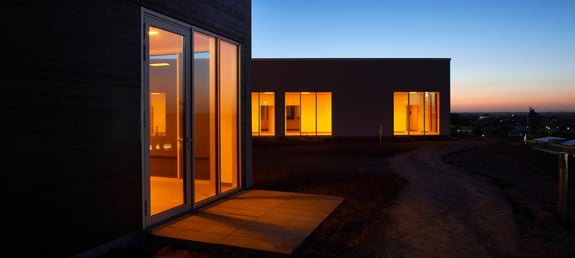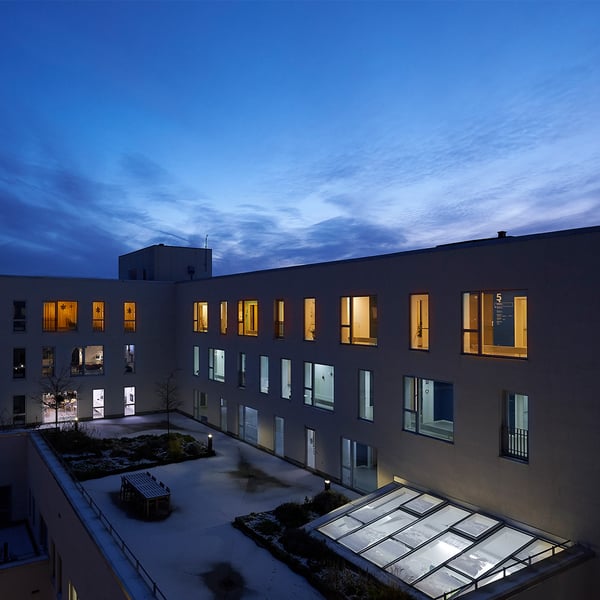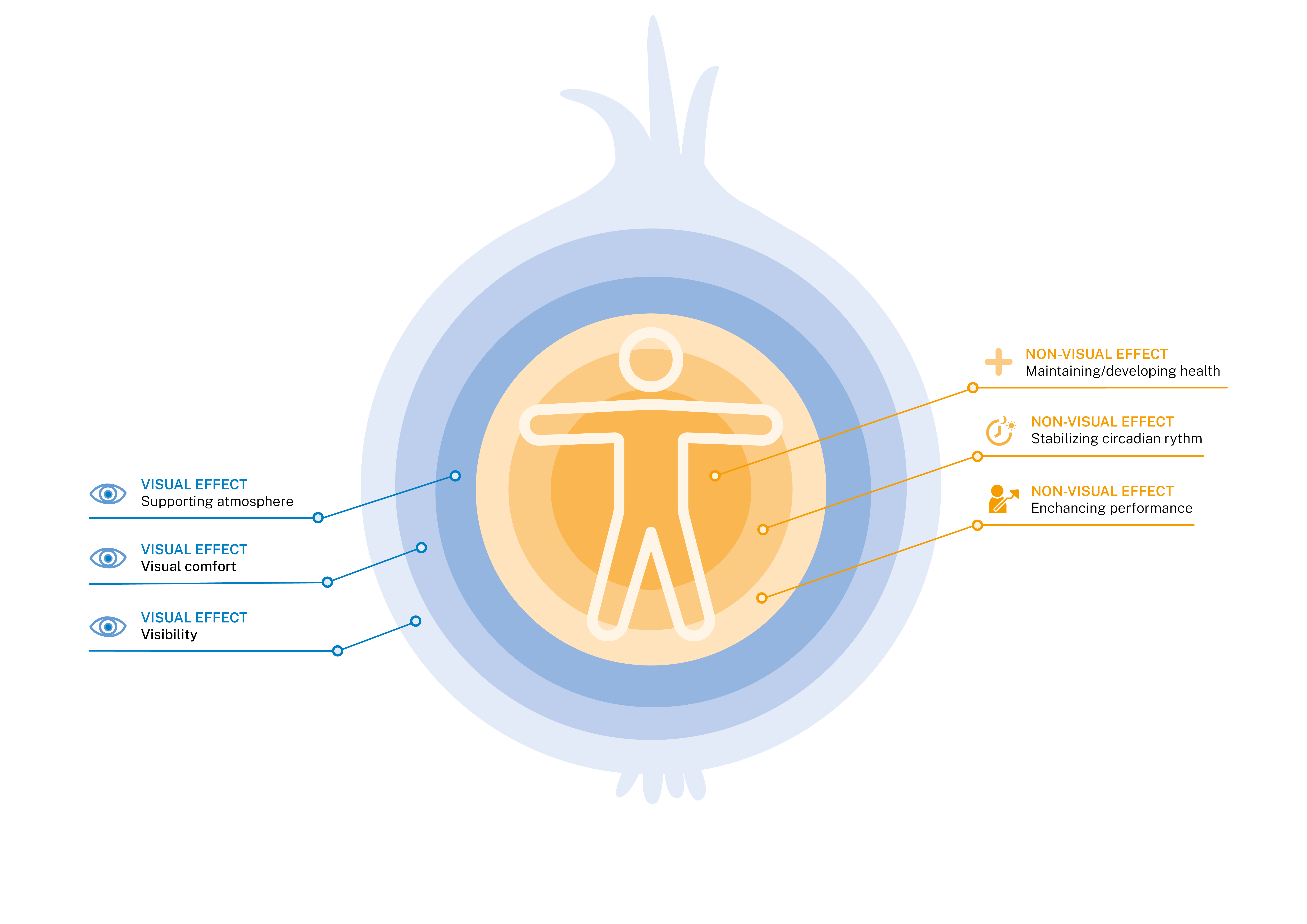
CREATE HEALTH WITH CIRCADIAN LIGHTING
TABLE OF CONTENTS
INTEGRATION OF HEALTH-PROMOTING LIGHTING
Do you have a specific construction or renovation project on your hands, and are you considering incorporating lighting into the project? It's important to realize that lighting is not just about illuminating a space.
Furthermore, many people often lack the necessary knowledge to integrate healthy and sustainable lighting that also provides economic benefits. Therefore, on this page, we will guide you through the essential areas needed to add value to the entire project.
THE PURPOSE OF LIGHTING
First and foremost, it is important to understand the purpose of having lighting. While most people know that lighting is used for visibility and creating ambiance in specific situations, its significance goes beyond that. Lighting also plays a crucial role in ensuring that we receive the optimal amount of light throughout the day to support biological and physiological processes, as well as have psychological effects on individuals. Thus, lighting becomes a key element in both physical and mental well-being.
Light is one of the primary factors that regulates the circadian rhythm or the body's internal clock. The human body is biologically programmed to be active during the day and rest at night. Exposure to natural light during the day and darkness at night helps maintain a healthy circadian rhythm, which is crucial for regulating the sleep-wake cycle, hormone production, and other biological processes such as metabolism, digestion, and immune function.
As we spend 90% of our day indoors, we are deprived of natural light and rely on artificial sources, emphasizing the importance of effective lighting in the buildings we inhabit.

THE CONSEQUENCE OF WRONG LIGHTING
Choosing the right lighting for building health is crucial. Opting for the wrong lighting can have significant consequences, as conventional lighting often leads to health issues.
The problems arise when lighting fails to consider human light needs throughout the day. This can create long-term challenges for businesses and organizations, resulting in increased sick leave, decreased performance, and overall employee discontent.
Conventional lighting can contribute to various health problems, including:

- Poor and fragmented sleep
- Appetite at the wrong times
- Compromised immune system
- Hormonal disturbances
- Bad mood and frustrations
- Increased depression
- Diminished performance
- Issues with heart rate and rhythm
- Noise and activity at inappropriate times
- Confusion
Read our blog post on the consequences of poor lighting design.
THE RHYTHM OF THE BUILDING
The challenges we face in relation to indoor lighting arise from our predominant indoor lifestyle. It may seem logical to conclude that spending so much time indoors is a problem. However, is it truly feasible to spend more time outdoors, and will this change in the future? Additionally, there are groups such as elderly citizens and patients who have no choice in the matter.
The real issue arises from the lack of a rhythm indoors in our buildings that aligns with human biological needs, and that the body expects and relies on.
To establish the optimal rhythm within the building, our first step is to analyze the specific needs, including the building's purpose, its users, the tasks to be performed, and considerations such as architecture and spatial layout.
The lighting should contribute to a positive work environment and support tasks at any time of day, while still prioritizing a healthy natural circadian rhythm to ensure the users' well-being is not compromised.
THE HEALTH-PROMOTING LIGHTING - CIRCADIAN LIGHTING
The health-promoting lighting establishes a natural rhythm for the building, resulting in numerous beneficial effects that all contribute to our health and well-being.
Circadian rhythm lighting is a cutting-edge technology crafted to mimic the natural progression of light throughout the day, aiming to influence human circadian rhythms, health, and well-being.
The circadian rhythm lighting automatically adjusts the color temperature and intensity throughout the day. It starts with a gentle sunrise in the morning, gradually transitioning to cooler, high-intensity light to boost energy and enhance focus as the day progresses. By late afternoon, the light softens and warms, promoting relaxation in the evening.
Døgnrythm lighting and human-centric lighting can be interpreted in various ways and are not just about adjusting color temperatures, as the tunable white concept is centered around. To ensure that you achieve a health effect with lighting, you need to know what guarantees the effect in the solution.
The non-visual impact of light on the body is the key factor in ensuring our health. The body interprets the time of day based on the influence of light and sends signals about its physiological and biological needs. Therefore, incorrect lighting at the wrong times can disrupt the body's understanding of its needs.
To measure the biological impact of light on health, a newer measurement method called Melanopic EDI is available. Based on research, a set of recommendations has been developed regarding the amount of Melanopic EDI individuals should receive at different times of the day to promote optimal health. This provides tangible data on the health-promoting effects, making it essential to inquire about this metric when integrating healthy lighting into your project.
It is crucial to always inquire about this measurement when integrating healthy lighting into your project.
Another crucial factor to ensure that your investment will have a positive impact on health is to inquire about the documentation of the health effects. Evidence of the effect can come from practical experiences as well as through clinical research. If the effect is supported by clinical research specific to the solution, it provides you with assurance that the solution will deliver the promised results. Moreover, additional practical experiences can complement the clinical research, offering you further peace of mind in selecting the solution. Always inquire about the documentation of the solution's effect, review the supporting studies, and the documented effects.
A solution alone does not guarantee success, as buildings and people are unique. That's why a carefully planned implementation process is crucial, starting with a user-centric approach from beginning to end. Analyzing the building and user needs is essential, with adjustments made accordingly. It's also vital to focus on post-installation support, user training, and continuous refinement based on real-world experiences.
Additionally, it's critical to tailor our approach to each unique project, as no two are alike. You can discover more about how we at Chromaviso customize our project workflows to meet these unique demands.

BENEFICIAL EFFECTS
With the right lighting that creates a rhythm in the building while also being tailored to users, spatial conditions, and architecture, along with an efficient yet thorough implementation, you can eliminate health problems and instead achieve a range of beneficial effects.
The work environment will be enhanced, and absenteeism reduced. Specifically, employees will experience:
- Improved sleep
- Increased energy
- Reduced stress
- Better mood
- Enhanced performance
- Less headaches
All of which impact their overall health and result in a healthier life in the long run. In the healthcare sector, the correct healthy lighting will also improve treatment, rehabilitation, and care for patients and citizens.
THE INVESTMENT
When investing in a lighting solution, price is a key factor to consider. There can be a significant difference in cost among the various solutions in the market. When comparing prices, it is important to focus on two main aspects:
- What is included in the price?
- What is the long-term ROI and financial impact?
Ensure that the pricing is comparable and that all services throughout the implementation process are included. Additionally, consider the health effects or consequences of different choices. How will reduced sick leave, for example, impact the overall outcome in the long run? And what about the lifespan of the products?

